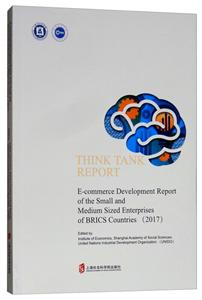預估到手價是按參與促銷活動、以最優惠的購買方案計算出的價格(不含優惠券部分),僅供參考,未必等同于實際到手價。
-
>
以利為利:財政關系與地方政府行為
-
>
立足飯碗 藏糧于地——基于中國人均耕地警戒值的耕地保護視角
-
>
營銷管理
-
>
茶葉里的全球貿易史(精裝)
-
>
近代華商股票市場制度與實踐(1872—1937)
-
>
麥肯錫圖表工作法
-
>
海龜交易法則
金磚國家中小企業電子商務報告2017(英文版) 版權信息
- ISBN:9787552024821
- 條形碼:9787552024821 ; 978-7-5520-2482-1
- 裝幀:一般膠版紙
- 冊數:暫無
- 重量:暫無
- 所屬分類:>>
金磚國家中小企業電子商務報告2017(英文版) 內容簡介
近幾年來,金磚國家電子商務的快速增長令全球矚目,金磚國家電子商務與中小企業的發展對經濟和就業的作用及影響日益突出。為促進中小企業和電子商務發展,從而促進包容可持續工業發展. 《金磚國家中小企業電子商務發展報告(2017 英文版)》比較完整地分析和揭示了金融危機以來金磚國家電子商務與中小企業的發展及現狀特征,探討了金磚各國在電子商務發展進程中面臨的問題以及挑戰。在全球貿易標準和貿易協定談判日益復雜、利益沖突日益尖銳的背景下,報告也特別探討了金磚國家在電子商務發展的相關法律法規與制度現狀和可能推動金磚國家電子商務貿易健康快速發展的貿易規則和標準制定,并對如何促進電子商務和中小企業發展提出了建議。
金磚國家中小企業電子商務報告2017(英文版) 目錄
1.1 Overall Situation
1.2 Essential Features of SMEs and e-commerce in BRICS countries
1.3 Main Problems Faced by e-commerce SMEs
1.4 Rules and Standards of e-commerce Trade in BRICS Countries
1.5 Proposals t6 Strengthen E-commerce Cooperation between BRICSs SMEs
2.Current Global Trends of e-commerce
2.1 Overview of Current Global Trends in e-commerce
2.1.1 Market size and Growth Rates
2.1.2 B2B.e-commerce is the main force of global e-commerce activities
2.1.3 B2C e-commerce is more active and growing significantly faster than B2B
2.1.4 e-commerce development across different regions
2.1.5 Outstandingperformance of emerging economies in global retail e-commerce
2.1.6 Great potential inBRICS e-commerce markets
2.2 The Impact of e-commerce on Global Economy, Technology Progress and Job Development
2.2.1 Impact of ICT on e-commerce market allocative efficiency
2.2.2 E-commerce is changing traditional business, production and sales models
2.2.3 Development of e-commerce promotes technological progress
2.2.4 E-commerce facilitates the development of SMEs and employment growth through business model innovation
2.2.5 Promote the participation of SMEs in the global economy
2.3 Global Development Trend of e-commerce
2.3.1 Mobile e-commerce is becoming mainstream
2.3.2 Cross-border e-commerce will be greatlydeveloped
2.3.3 The e-commerce industry chain and service ecology form gradually
2.3.4 The impact of social media on e-commerce activities is becoming increasingly prominent
2.3.5 The global e-commerce will gradually shift to emerging regional markets
2.3.6 The e-commerce activities in SMEs will usher in an era of economic development
3.Current Status of E-commerce among SMEs
3.1 Brazil
3.1.1 Overall status of SMEs
3.1.2 Overall status of e-commerce development in Brazil
3.1.3 Development status of E-commerce among SMEs
3.1.4 Development status of cross-border e-commerce
3.1.5 Management institutions and policies
3.1.6 Case study: E-commerce sales optimization and expand overseas markets
3.2 Russia
3.2.1 Overall status of SMEs
3.2.2 Overall status of e-commerce development in Russia
3.2.3 Development status of SMEs e-commerce
3.2.4 Development status of cross-border e-commerce
3.2.5 Management institutions and policies
3.2.6 Case Study: e-commerce helped Afour to expand overseas
3.3 India
3.3.1 Overall status of SMEs
3.3.2 Overall status of e-commerce development in India
3.3.3 Development status of cross-border e-commerce
3.3.4 Management institutions and policies
3.3.5 Case study: Makemytrip use e-commerce to expand global market
3.4 China
3.4.1 Development status of SMEs
3.4.2 General situation of China's e-commerce development
3.4.3 E-commerce development status of SMEs
3.4.4 Development status of cross-border e-commerce
3.4.5 Regulatory departments and policies
3.4.6 Practice cases: The road of "Three Squirrels" to IPO
3.5 South Africa
3.5.1 Overall status of SMEs
3.5.2 Overall status of e-commerce development in South Africa
3.5.3 Development status of SMEs e-commerce
3.5.4 Management institutions and policies
3.5.5 Case study: UAfrica enhance efficiency with the cloud
4.Major Issues in the Development of e-commerce among BRICS SMEs
4.1 Common Issues in the Development of BRICS SMEs e-commerce
4.1.1 Information communication infrastructure still lags behind
4.1.2 Logistics could not meet the demand of rapidly growing e-commerce
4.1.3 Shortage of e-commerce related qualified personnel
4.1.4 Market regulation and credit-sys'tem need to be strengthened
4.1.5 The e-commerce regulatory system need to be further improved
4.2 Major Country Specific Issues Faced by SMEs in BRICS
4.2.1 Brazil
4.2.2 Russia
4.2.3 India
4.2.4 China
4.2.5 South Africa
5.The Laws, Regulations and Systems of e-commerce in BRICS Countries
5.1 The Status of Laws, Regulations, Standards, and Systems in BRICS Countries.
5.1.1 The laws and regulatory rules of e-commerce
5.1.2 E-commerce trade and investment policy
5.1.3 Data and security regulations for e-commerce
5.1.4 Protection of consumer rights, interests in e-commerce and protection of intellectual property rights
5.2 The Evaluation and Comparison of the Policy Standards of E-commerce in BRICS
5.2.1 Completeness evaluation: the integrity and systematic nature of legal norms
5.2.2 Convenience evaluation: support for trade and investment policy
5.2.3 Security evaluation: transaction security and consumer protection
5.3 The Establishment of Unified Standard for Cross-border e-commerce in BRICS
5.3.1 The significance of unifying the standard of cross-border e-commerce in BRICS countries
5.3.2 Difficulties in establishing unified standard of cross-border e-commerce in BRICS countries
5.3.3 Policy suggestions for establishing standard rules of cross-border e-commerce in BRICS Countries
6.Further Strengthen the BRICS National E-commerce Cooperation
6.1 Strategic Framework to Strengthen the E-commerce Cooperation between BRICS
6.2 Continue to Improve the Cooperation Mechanism to Promote BRICS E-commerce Development
6.2.1 Strengthen the consensus and vision of e-commerce cooperation
6.2.2 Strengthen the implementation to promote e-commerce
6.3 Strengthen the BRICS Capacity Building to Promote E-commerce Cooperation
6.3.1 Cooperation in infrastructure development
6.3.2 Cooperation on technical support for e-commerce development
6.3.3 Cooperation on e-commerce skill and professional training
6.4 Strengthen cross-border e-commerce cooperation among BRICS countries
6.4.1 Focus on strengthening the cross-border trade of the dominant BRICS products
6.4.2 Promote the development control of cross-border e-commerce and simplification of trade rules
6.4.3 Strengthen the security, legal cross-border delivery and cooperation of information and data exchange
6.5 Promote Cooperation and Development of SMEs in BRICS
References
金磚國家中小企業電子商務報告2017(英文版) 作者簡介
上海社會科學院經濟研究所,成立于1956年,主要從事政治經濟學、西方經濟學、經濟思想史與經濟史、人口資源與環境經濟學、統計學與數量經濟學等基礎理論的研究。近年來,為順應國家高端智庫建設,經濟研究所注重學科建設和智庫發展雙輪驅動。60多年來,上海社會科學院經濟研究所云集了一批蜚聲學界的經濟學大師,形成了一批具有重要影響力的學術成果,打造了《上海經濟發展藍皮書》年度報告、《上海經濟研究》期刊等一批學術品牌。近年來,上海社會科學院經濟研究所加強同國內外學術機構、政府部門、社會組織和企業的交流,產出了大量決策咨詢成果/聯合國工業發展組織(UNIDO)(簡稱“工發組織”)成立于1966年,截至2017年12月31日,擁有168個成員國。作為聯合國的一個專門機構,工發組織一直致力于促進減貧、包容性全球化和環境可持續的工業發展。2013年,工發組織《利馬宣言》的通過和《2030年可持續發展議程》17項可持續發展目標的提出,賦予了工發組織新的使命,即推動成員國實現包容與可持續工業發展(ISID)以及可持續發展目標“建造具備抵御災害能力的基礎設施,促進具有包容性的可持續工業化,推動創新”。目前,工發組織以創造共享繁榮、提升經濟競爭力和保護環境為宗旨,在農產工業和農村發展、貿易能力建設、質量基礎設施建設、促進技術交流與轉移、推動中小企業發展、促進性別平等、提高資源利用效率和低碳生產、推廣清潔能源、執行多邊環境協定等領域為成員國提供政策咨詢,開展廣泛的技術合作,為發展中國家和最不發達國家消除貧困,實現可持續發展作出了積極貢獻,促進了世界發展與共同繁榮。
- >
二體千字文
- >
經典常談
- >
推拿
- >
月亮與六便士
- >
小考拉的故事-套裝共3冊
- >
名家帶你讀魯迅:朝花夕拾
- >
伊索寓言-世界文學名著典藏-全譯本
- >
羅曼·羅蘭讀書隨筆-精裝
















